How to Install Google Analytics on Blogger

Wouldn’t it be nice to know how many people actually visited your
blog each day? How about knowing which of your posts are the
most popular? Well surprisingly Blogger doesn’t currently offer
any native blog analytics but fortunately there is Google Analytics —
available for free.
Google Analytics is a great tool that will show you all sorts of useful
information about how people found your blog, keywords they searched
on to find you, where they came from and even how long they stayed.
You’ll learn more about where your visitors come from and how they
interact with your blog. This is a must tool if you are trying to build
a profitable blog otherwise you are flying blind!
This article will show you how to add Google Analytics to your
Blogger blog. It’s a fairly simple process and doesn’t require
any technical skill at all.
Step #1 – Setup a Google Analytics Account
Go to Google Analytics and sign in using your Blogger login.
If your account doesn’t work for some reason, you can create
a new one instead.
Once you login you’ll see a screen that looks like this:

Click on the “Sign Up >>” button and proceed to the next step which
will ask you for your general information. Website URL, Account Name,
Country, and Time Zone. The screen will look like this:
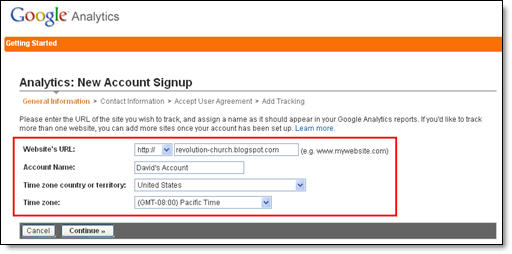
If you noticed, I just put my Blogger url (without the http://) and called it
“David’s Account” because this is your top-level container for 1 or 100
different websites so it’s a good idea to name it something more general.
The next step will ask you for your contact information which includes your
first name, last name, phone number, and country. Easy so far right? ![]()
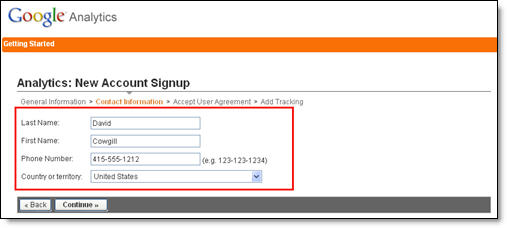
Your last step in signing up will ask you to accept the user agreement
terms and conditions which you should read (just kidding…who
actually ever reads these entire legal terms anyhow?).
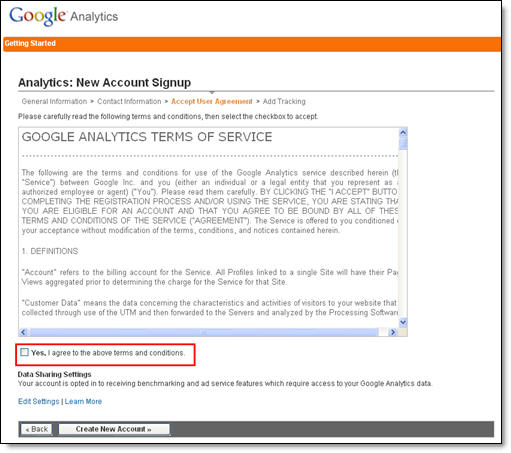
Now this next screen is very important. This is the code you will need to
copy and paste into your blogger template. Go ahead and click into the
box and it will automatically highlight the entire block of code for you.
Now you need to copy that code and paste it into notepad or into a
MS Word document. Save it as you’ll need to use it later.
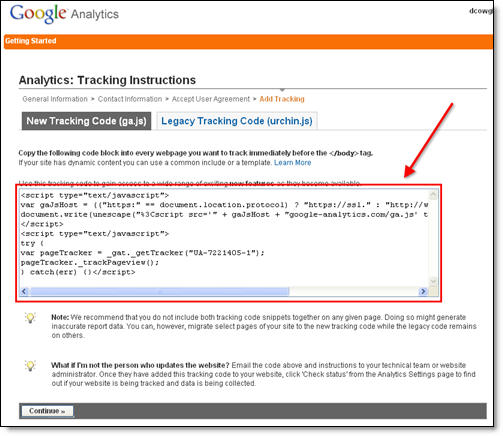
After you click on the “continue >>” button you will be taken to
your brand new Google Analytics dashboard! You will see your
blogger blog listed but with no analytical data….yet.
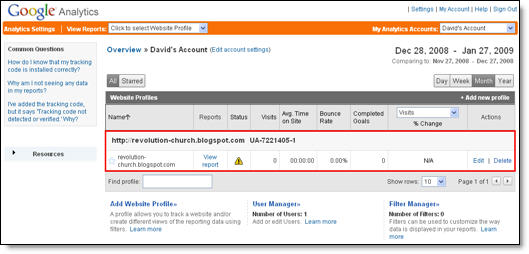
Ok, now you are done with setting up your Google Analytics account.
The next step is placing the tracking code into your Blogger template so
it can report back to Google Analytics and provide you with some cool
data points.
Step #2 – Adding GA Tracking Code to Your
Blogger Template
This is not a very difficult step even if you are afraid to touch your template
code. Login to your Blogger account and then click on the “Layout” =>
“Edit HTML” tabs. This will bring you to the template code. Before you
make any changes, I advice you to back up your template just in case
there are any problems. After you’ve done so, continue reading.
Now in the edit template html code window, scroll all the way to the
bottom of your template code and look for the tag. There should
only be one of these closing tags in your template. If you can’t find it
then your template wasn’t properly created and you should add one right
above the tag.The tag should always be your last
line of code in your template. It signifies the end of your template.
Ok, now go back to the code you saved before in a Word Doc from
Google Analytics. You are going to copy it and paste it right above the
tag as illustrated in the image below. The yellow highlighted
code is the new GA code I just pasted into my template.
Save your template and you shouldn’t get any error messages.
If you do, it’s most likely not related to this GA code and something
else with your template itself. Assuming you’ve been successful
with your save, you are all done embedding the GA code in
your template!
Step #3 – Confirm Google Analytics is Tracking
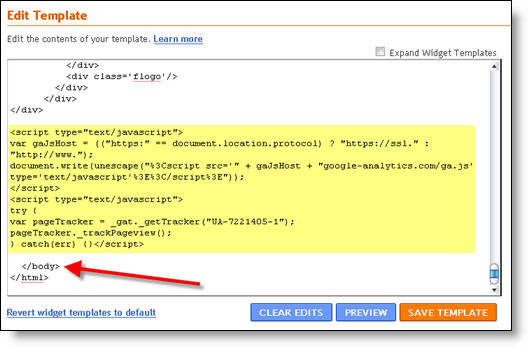
Go back into your Google Analytics account and look at your dashboard.
Most likely you will see a little yellow exclamation mark under the
“status” column that looks like this: ![]() . This means everything isn’t
. This means everything isn’t
working properly yet which is fine because we are about to tell GA
we just added the code. From your dashboard, click on the “edit”
link which is located to the far right.
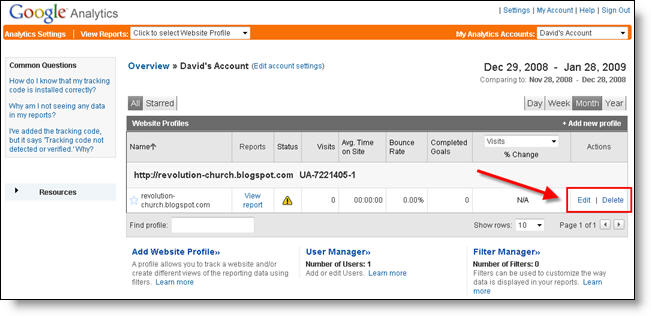
After you click on that link, you’ll see another screen like below.
It will say “Tracking Not Installed” followed by a link “Check Status”.
You’ll want to go ahead and click on that link which will tell GA to
visit your site and look for the new code you just pasted in
your template.
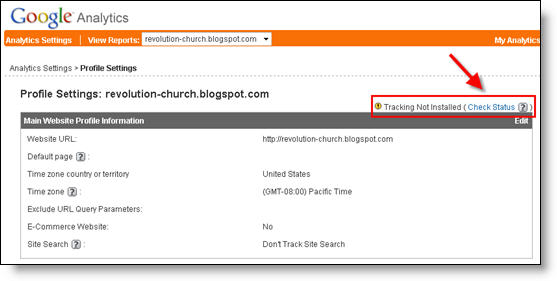
Assuming you pasted the code in there as instructed above,
GA will find the new code and begin tracking everything on your blog.
If you are still having problems, it’s most likely something to do with
GA and you should read their help guide to troubleshoot your problem.

The message seen here, “Waiting for Data” means you have correctly
setup GA and data is being gathered! Click on the top left Google Analytics
logo and it will take you back to your dashboard. From there click on the
“View report” link and that’s where all your very important Blogger visitor
data will start appearing!
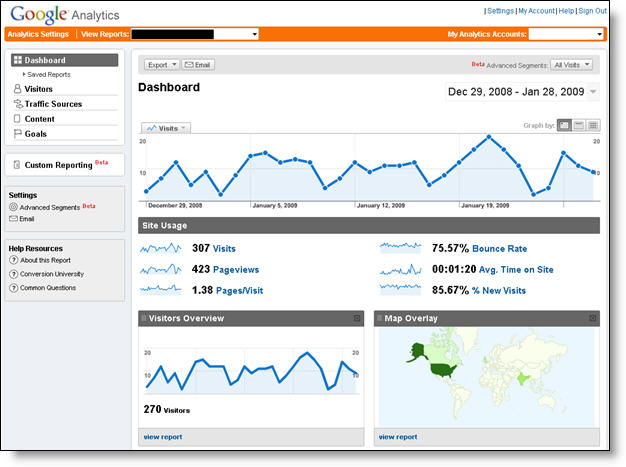
Now it usually takes an hour or so before you will see any data
(maybe longer if you don’t get much traffic to your blog) so please be
patient. Trust me, you’ll be logging in at least once a day just to see
how much traffic your blog is getting. It’s very addicting and powerful
information to learn from. You’ll be surprised which posts are your
most popular and what countries people are coming from to read
your blog.
Google Analytics is very powerful and we have just learned how to install it
into your Blogger template. We haven’t even scratched the surface on
the features and reporting it can do. For most Bloggers, this will be
enough. Data will be collected and you will just review it. Others with
more in-depth goals (like selling products or services, creating a sales
funnel, etc) will want to spend more time learning GA. Hope you enjoyed
the tutorial and don’t blame me for your new found addiction!
Ready to super charge your blog? Check out our professional
premium blogger templates or make money by joining our
blog affiliate program!
If you like this post then please consider subscribing to our
eBlog Templates RSS feed. You can also subscribe by email
and have new templates and articles sent directly to your inbox.













